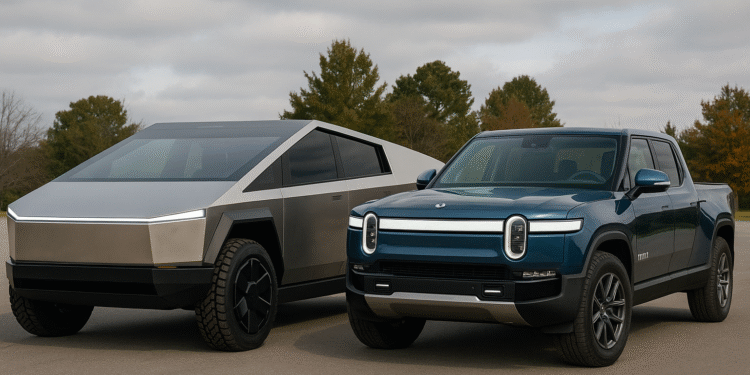Tesla Cybertruck vs Rivian R1T: Which Electric Truck is Better for Sustainable Tech Enthusiasts?
The electric vehicle revolution has finally reached the pickup truck segment, traditionally dominated by gas-guzzling behemoths. For sustainability-minded consumers who need the utility of a truck, two groundbreaking options stand out: the futuristic Tesla Cybertruck and the adventure-ready Rivian R1T. Both vehicles represent a paradigm shift in how we think about trucks, combining zero-emission driving with cutting-edge technology and impressive capabilities.
As more drivers seek to reduce their carbon footprint without sacrificing utility, these electric trucks offer compelling alternatives to conventional pickups. But which one better serves the needs of sustainable tech enthusiasts? This comprehensive comparison examines everything from design philosophy and performance metrics to environmental impact and ownership experience, helping you determine which electric truck aligns with your values and requirements.

Design & Aesthetics: Breaking Traditions vs. Refined Evolution
The visual contrast between these two electric trucks couldn’t be more striking. Each represents a fundamentally different approach to reimagining what a pickup truck can be in the electric era.
Tesla Cybertruck: Radical Departure
The Cybertruck shatters conventional truck design with its angular, stainless steel exoskeleton. Tesla deliberately avoided the traditional truck template, instead creating something that looks like it rolled straight out of a sci-fi movie. The unpainted 30x cold-rolled stainless steel body serves both aesthetic and functional purposes – eliminating the need for paint (reducing environmental impact) while providing exceptional durability.
Its triangular profile and flat panels create a polarizing appearance that demands attention. The minimalist interior features a 18.5-inch center screen and a yoke-style steering wheel, continuing the futuristic theme inside. The Cybertruck’s design makes a bold statement about rethinking what trucks can be, though it may alienate traditionalists.

Rivian R1T: Thoughtful Evolution
The Rivian R1T takes a more evolutionary approach, maintaining recognizable truck proportions while introducing distinctive modern elements. Its smooth surfaces, vertical oval headlights, and full-width light bars create an approachable yet forward-thinking aesthetic. The R1T looks unmistakably like a truck but with a clean, sophisticated design language that signals its electric nature.
Inside, the R1T blends premium materials with sustainable options like vegan leather and reclaimed wood. The interior feels both luxurious and adventure-ready, with thoughtful storage solutions throughout. The panoramic glass roof connects occupants with the outdoors, reinforcing Rivian’s emphasis on environmental appreciation.

Cybertruck Design Advantages
- Unprecedented durability with stainless steel exoskeleton
- No paint needed, reducing environmental impact
- Distinctive appearance that stands out
- Aerodynamic shape improves efficiency
- Innovative vault cover for secure storage
Rivian R1T Design Advantages
- More approachable, familiar truck aesthetic
- Innovative gear tunnel for additional storage
- Thoughtful integration of sustainable materials
- Better visibility for the driver
- More conventional interior controls
Want to stay updated on sustainable vehicle design?
Subscribe to our newsletter for the latest developments in eco-friendly automotive innovation.
Subscribe NowPerformance & Capabilities: Power Meets Practicality
Both trucks deliver impressive performance that challenges conventional notions of what electric vehicles can do, especially in the utility segment. Let’s examine how they compare in key performance metrics.
| Specification | Tesla Cybertruck (Cyberbeast) | Rivian R1T (Quad-Motor) |
| Range | 320 miles | 328 miles |
| Horsepower | 845 hp | 835 hp |
| 0-60 mph | 2.6 seconds | 3.0 seconds |
| Towing Capacity | 11,000 lbs | 11,000 lbs |
| Payload Capacity | 2,500 lbs | 1,760 lbs |
| Ground Clearance | 16 inches (max) | 14.9 inches (max) |
| Bed Length | 6.5 feet (with tailgate down) | 4.5 feet |
Range & Efficiency
Both trucks offer impressive range figures, with the Rivian R1T slightly edging out the Cybertruck in EPA-estimated range. However, real-world testing by owners suggests that the Cybertruck may struggle to reach its rated range when loaded or driven at highway speeds. The R1T has proven more consistent in delivering close to its estimated range in varied conditions.
Efficiency is another important consideration for sustainability-minded buyers. The Cybertruck’s aerodynamic shape helps it achieve better efficiency than might be expected given its size and weight. The R1T, while slightly less efficient on paper, benefits from Rivian’s sophisticated battery management system that helps preserve range in extreme conditions.

Off-Road Capabilities
For sustainable tech enthusiasts who enjoy outdoor adventures, off-road capability is crucial. The Rivian R1T excels here with its quad-motor setup providing precise torque vectoring to each wheel. Its hydraulic roll control system, adjustable air suspension, and multiple drive modes make it exceptionally capable off the beaten path.
The Cybertruck counters with impressive ground clearance in its highest suspension setting and four-wheel steering that improves maneuverability on tight trails. However, early owners report that the Cybertruck’s differential lockers are not yet activated via software, limiting its off-road potential compared to the R1T.


Towing & Hauling
Both trucks offer impressive towing capabilities, with each rated to pull up to 11,000 pounds. The Cybertruck edges ahead in payload capacity, able to carry 2,500 pounds versus the R1T’s 1,760 pounds. The Cybertruck’s longer bed (6.5 feet with the tailgate down) provides more cargo space than the R1T’s more compact 4.5-foot bed.
However, the R1T compensates with innovative storage solutions like the gear tunnel – a horizontal compartment behind the cab that provides 11.6 cubic feet of lockable storage. The Cybertruck counters with its “frunk” (front trunk) and under-bed storage.
It’s worth noting that towing significantly reduces range in both vehicles – expect a 30-50% reduction when pulling heavy loads, which is typical for all electric vehicles.
Ready to explore electric truck performance in depth?
Download our comprehensive EV truck performance guide with detailed range testing and towing analysis.
Get the Free GuideTech Features: Innovation Beyond the Powertrain
Both the Cybertruck and R1T showcase cutting-edge technology that extends far beyond their electric powertrains. From advanced driver assistance systems to unique features that enhance utility, these trucks represent the convergence of automotive and tech innovation.
Infotainment & Controls
Tesla Cybertruck Interface
The Cybertruck follows Tesla’s minimalist approach with a single 18.5-inch horizontal touchscreen that controls virtually all vehicle functions. The system runs Tesla’s proprietary software, known for its intuitive design and regular over-the-air updates that add new features and refinements.
The steer-by-wire system with its yoke-style steering control represents a radical departure from traditional truck controls. This system allows for variable steering ratios that adjust based on speed and driving mode, making the large truck surprisingly maneuverable at low speeds while providing stability at highway speeds.

Rivian R1T Interface
The R1T features a more conventional but still tech-forward approach with a 15.6-inch central touchscreen and a 12.3-inch digital instrument cluster. Rivian’s interface emphasizes outdoor adventure with navigation features specifically designed for off-road use, including topographical mapping and trail guides.
Physical controls complement the touchscreen for frequently used functions, striking a balance between digital innovation and practical usability. The R1T also features a removable Bluetooth speaker that stows in the center console – a thoughtful touch for outdoor adventures.

Driver Assistance Systems
Tesla offers its controversial Full Self-Driving (FSD) capability as an option on the Cybertruck, though it remains a Level 2 driver assistance system requiring constant supervision. The system leverages Tesla’s extensive real-world data collection and neural network training to provide advanced features like automatic lane changes and navigation on autopilot.
Rivian counters with its Driver+ system, which includes adaptive cruise control, lane keeping, and automatic emergency braking. While not as ambitious as Tesla’s FSD, early reviews suggest Rivian’s system delivers consistent performance in its intended use cases without overpromising capabilities.

Unique Tech Features
Cybertruck Innovations
- Armor glass windows (with variable opacity in development)
- Power-retractable tonneau cover
- Built-in 120V and 240V power outlets (up to 11.5 kW)
- Four-wheel steering with crab walk capability
- Adaptive air suspension with 6 inches of adjustment
R1T Innovations
- Gear Tunnel pass-through storage with power outlets
- Camp Kitchen option that slides out from gear tunnel
- Built-in air compressor for tires and equipment
- Flashlight integrated into driver’s door
- Hydraulic roll control suspension system
Shared Tech Features
- Over-the-air software updates
- Smartphone app for remote control
- Integrated dashcam/security system
- Vehicle-to-load power capability
- Advanced climate control with heat pump
Charging Infrastructure
Tesla maintains a significant advantage with its extensive Supercharger network, which now includes over 50,000 chargers globally. The Cybertruck can charge at up to 250 kW, with Tesla promising future capability of up to 350 kW. This infrastructure makes long-distance travel more convenient in the Cybertruck.
Rivian is building its Adventure Network of fast chargers, but it’s still in early stages with fewer locations. However, R1T owners can access Tesla Superchargers through an adapter, as well as other public charging networks. The R1T supports charging speeds up to 220 kW.
For home charging, the Cybertruck includes a 48-amp onboard charger, while the R1T offers a similar 48-amp capability. Ford’s F-150 Lightning, for comparison, offers an 80-amp home charging solution, giving it an advantage for overnight charging speed.

Curious about the future of EV charging?
Join our webinar on how smart grids and renewable energy are transforming the EV charging landscape.
Register for WebinarSustainability: Beyond Zero Emissions
For environmentally conscious tech enthusiasts, sustainability extends beyond the zero-emission driving experience. Manufacturing processes, material choices, and company values all contribute to the overall environmental impact of these vehicles.
Manufacturing & Materials
Tesla’s Approach
The Cybertruck’s stainless steel exoskeleton eliminates the need for paint, reducing chemical usage and emissions from the painting process. Tesla claims the manufacturing process is simplified by the use of flat panels and fewer parts, potentially reducing energy consumption during production.
Tesla has made strides in battery recycling through its partnership with Redwood Materials, aiming to create a closed-loop battery supply chain. The company has also committed to using renewable energy at its Gigafactories, though implementation varies by location.

Rivian’s Approach
Rivian has made sustainability central to its brand identity. The company uses recycled materials throughout the R1T, including vegan leather alternatives and reclaimed wood for interior trim. Rivian’s “Forever” battery warranty includes recycling provisions to ensure responsible end-of-life handling.
The company has established the Rivian Forever fund, pledging 1% of equity to environmental initiatives. Rivian has also committed to carbon-neutral manufacturing by 2028 and has invested in renewable energy projects to offset its current carbon footprint.

Carbon Footprint Analysis
Electric vehicles typically produce more carbon emissions during manufacturing than conventional vehicles, primarily due to battery production. However, they quickly make up this difference through zero-emission operation, especially when charged with renewable energy.
While comprehensive lifecycle analyses for these specific models are still emerging, preliminary data suggests both vehicles will have significantly lower lifetime carbon footprints than comparable gas-powered trucks. The exact comparison between the Cybertruck and R1T depends on factors including:
- Energy sources used in manufacturing
- Regional electricity grid mix where the vehicle is charged
- Battery longevity and eventual recycling
- Total lifetime mileage

Corporate Sustainability Commitments
| Sustainability Aspect | Tesla | Rivian |
| Renewable Energy Goals | 100% renewable energy for all operations (timeline varies by facility) | Carbon-neutral manufacturing by 2028 |
| Battery Recycling | In-house recycling program plus partnership with Redwood Materials | Battery recycling included in “Forever” battery warranty |
| Sustainable Materials | Increasing use of recycled materials, no animal products in some models | Extensive use of recycled materials and vegan alternatives |
| Environmental Initiatives | Focus on accelerating transition to sustainable energy | Rivian Forever fund pledging 1% of equity to environmental causes |
| Transparency | Annual Impact Report with environmental metrics | Detailed sustainability reporting and third-party verification |
“The environmental impact of an electric vehicle extends far beyond its zero-emission driving. Manufacturing processes, material sourcing, and end-of-life recycling all contribute to the true sustainability story.”
Dr. Jennifer Morris, Environmental Impact Researcher
Passionate about sustainable transportation?
Join our community of eco-conscious tech enthusiasts to discuss the latest in green mobility solutions.
Join the CommunityPrice & Availability: Investment in Sustainable Technology
Electric trucks represent a significant investment, with prices reflecting their cutting-edge technology and capabilities. Let’s examine how the Cybertruck and R1T compare in terms of pricing, availability, and overall value proposition.
Pricing Structure
| Model | Base Price | Top Trim Price | Tax Incentives |
| Tesla Cybertruck | $60,990 (RWD) | $99,990 (Cyberbeast) | Partial federal tax credit eligibility |
| Rivian R1T | $73,000 (Dual Motor) | $95,000 (Quad Motor) | Full $7,500 federal tax credit eligible |
The Cybertruck offers a lower entry point with its rear-wheel-drive model, though most buyers will likely opt for the all-wheel-drive ($79,990) or Cyberbeast ($99,990) variants. The R1T starts higher but includes more standard features in its base configuration.
It’s worth noting that Rivian has adjusted its pricing several times since launch, which has frustrated some reservation holders. Tesla has also deviated from initially announced pricing for the Cybertruck, with final prices significantly higher than the $39,900 base price announced in 2019.

Availability & Production
Rivian has been delivering the R1T since late 2021, giving it a significant head start in real-world customer experience. Current wait times for new R1T orders are typically 2-3 months, as Rivian has worked through its initial reservation backlog and ramped up production.
The Cybertruck began deliveries in late 2023, with Tesla slowly increasing production throughout 2024. Current wait times for new orders extend 6-12 months depending on configuration. Tesla has a history of production challenges with new models but also a track record of eventually achieving high-volume manufacturing.
Geographic availability is another consideration. Rivian currently focuses primarily on the North American market, while Tesla has global distribution channels that may eventually make the Cybertruck available internationally (though regulatory hurdles remain in some markets).
Total Cost of Ownership
Beyond the purchase price, sustainable tech enthusiasts should consider the total cost of ownership, which includes:
Cost Advantages
- Lower “fuel” costs (electricity vs. gasoline)
- Reduced maintenance (fewer moving parts)
- Potential insurance discounts for safety features
- Tax incentives and rebates
- Higher residual value (projected)
Additional Considerations
- Home charging installation costs
- Battery replacement (if needed beyond warranty)
- Software subscription fees for premium features
- Potential higher insurance premiums
- Electricity rate variations by region
Both manufacturers offer comprehensive warranties, with Rivian’s battery warranty extending to 8 years/175,000 miles and Tesla offering 8 years/120,000 miles for the Cybertruck battery and drive units.
Federal Tax Credit Status
As of 2024, the Rivian R1T qualifies for the full $7,500 federal tax credit under the Inflation Reduction Act guidelines. The Tesla Cybertruck currently qualifies for a partial credit, with the amount varying based on battery sourcing and manufacturing location. State and local incentives may provide additional savings depending on your location.
Ready to calculate your potential savings?
Use our EV ownership calculator to compare total cost of ownership between electric trucks and conventional alternatives.
Calculate Your SavingsVerdict: Which Electric Truck is Better for Sustainable Tech Enthusiasts?
After examining design, performance, technology, sustainability, and value, it’s clear that both the Tesla Cybertruck and Rivian R1T offer compelling packages for different types of sustainable tech enthusiasts. Rather than declaring an overall winner, let’s identify which truck might better serve specific buyer profiles.
Best for Innovation Seekers

The Tesla Cybertruck pushes boundaries with its radical design, steer-by-wire system, and exoskeleton construction. If you value cutting-edge technology and appreciate Tesla’s approach to continuous improvement through software updates, the Cybertruck represents the more revolutionary choice.
Innovation seekers will appreciate the Cybertruck’s unique features like four-wheel steering with crab walk mode, adaptive air suspension, and integration with Tesla’s ecosystem including Powerwall home energy storage.
Best for Outdoor Enthusiasts

The Rivian R1T was purpose-built for adventure with thoughtful features like the gear tunnel, integrated air compressor, and removable Bluetooth speaker. Its sophisticated off-road capabilities, including hydraulic roll control and multiple terrain modes, make it the superior choice for those who regularly venture off the beaten path.
Outdoor enthusiasts will appreciate Rivian’s focus on practical utility and the R1T’s more approachable learning curve compared to the Cybertruck’s futuristic controls.
Best for Eco-Conscious Buyers

While both vehicles offer environmental benefits through zero-emission driving, the Rivian R1T demonstrates a more holistic commitment to sustainability through its material choices, corporate initiatives, and transparent environmental reporting.
Eco-conscious buyers will appreciate Rivian’s explicit environmental mission and the integration of sustainable materials throughout the vehicle, as well as the company’s commitment to preserving outdoor spaces through the Rivian Forever fund.
Final Considerations
Which truck offers better value?
Value depends on your priorities. The Cybertruck offers more range per dollar at its entry point, while the R1T includes more standard features and currently qualifies for the full federal tax credit. For pure utility, the Cybertruck’s larger bed and higher payload capacity may represent better value for those who regularly haul cargo.
Which has better software and updates?
Tesla has a longer track record of meaningful over-the-air updates that add features and improve performance. However, Rivian has been aggressive with its update schedule since launch, addressing owner feedback and adding new capabilities. Tesla’s software tends to be more feature-rich but occasionally less refined, while Rivian’s approach prioritizes stability and user experience.
Which truck is more future-proof?
Both manufacturers have demonstrated commitment to keeping their vehicles current through software updates. Tesla’s vertical integration and control over its Supercharger network may provide advantages as charging standards evolve. Rivian’s modular approach to hardware and strong focus on software development suggests good long-term support as well.
Which has a longer range?
On paper, the Rivian R1T with the Large pack offers slightly more range (328 miles) than the Cybertruck AWD (320 miles). However, real-world range varies based on driving conditions, load, and climate. Rivian has announced a Max pack option that will extend range to approximately 400 miles, while Tesla has mentioned but not yet delivered a range-extended Cybertruck variant.

Ultimately, both the Tesla Cybertruck and Rivian R1T deliver on their promises to reinvent what a pickup truck can be in the electric era. Your personal priorities regarding design aesthetic, feature set, and brand values will likely determine which vehicle better aligns with your vision of sustainable technology.
As early entrants in the electric truck market, both vehicles will continue to evolve through software updates and iterative improvements. Whichever you choose, you’ll be participating in the important transition toward more sustainable transportation options – a win for technology enthusiasts and the environment alike.
Share your thoughts on these revolutionary electric trucks!
Join the conversation and connect with other sustainable tech enthusiasts to discuss the future of electric vehicles.
Leave a Comment





















































